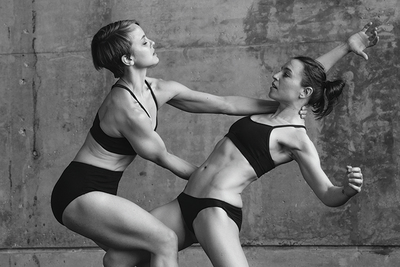Doppelgänger Dance Collective

l. to r. Shura Baryshnikov and Danielle Davidson at the Baryshnikov Arts Center, NYC, on January 18, 2016. Photo: Marc Pilaro.
“Imagine that you’re playing connect the dots in your body,” says the choreographer Alissa Cardone. With their eyes closed, the dancers, Shura Baryshnikov and Danielle Davidson (co-artistic directors of Doppelgänger Dance Collective) each move to their own imagination. One lifts her hipbone up toward her ribs; the other brings an elbow to a knee. “Now imagine your face is at a party socializing.” One smiles and winks. The other nods her head.
Doppelgänger, which in German means, “double-walker” is an apt name for Barysh-nikov and Davidson’s contemporary dance company created for duet performance. Each dance showcases their impressive physicality, their diverse movement histories and techniques but is a dialogue with each other. On the dance floor, “We’re friends, we’re colleagues, we’re sisters, we’re lovers, we’re haters. We’re all of these things,” says Davidson.
Baryshnikov, age 35, is the daughter of ballet great Mikhail Baryshnikov and actress Jessica Lange. She has danced all of her life but “refused to identify [her]self as a performer or movement artist.” It wasn’t until 2008, after years of raising her young daughters and jobs in design and arts administration that she returned to performing. “At the beginning I took any job someone offered me, I taught 13 classes a week at different studios…I did the work. I built my capacity and earned my own place in this community,” she says.
Davidson, also 35 years old, fell in love with ballet at 12, went to a professional ballet school and joined a company at 17. She discovered contemporary dance in her early 20s and thought the physicality of release technique suited her best. The two met in a dance class at AS220 in Providence, RI, where they both live. “There was a pull, an energy, that brought us together and pushes us forward,” says Davidson. They formed their collective in 2015 with a mission “to give Rhode Island audiences diverse dance experiences.”
Doppelgänger commissions a new choreographer each season. They are also committed to live music whenever possible. Last year they, with their various choreographers and musicians, created four works. One of them, The Trail We Left Behind (by Kellie Ann Lynch with an original score by Caitlin Scholl), was performed in Providence’s Kennedy Plaza. The site-specific dance reflected the diversity of movements and emotions one would expect from a public square where all walks of life congregate.
With Cardone, Doppelgänger has received a creative residency as Catalyst artists through the Dance Complex in Cambridge, MA, which culminates in a series of performances in January. In this first rehearsal with Cardone, on an unseasonably hot September afternoon, Cardone starts Baryshnikov and Davidson with some improv warm-ups. They are developing a shared imagery and language. Their movements are somatically driven—what it feels like in their bodies as opposed to what it looks like.
After warm-ups, they gather around an art book by Hannah Höch, a German Dadaist, to study Quarrel, a photomontage. Cardone instructs them to move like the characters in the picture. Davidson mimes by gathering up hay from the ground and drags her finger along the floor as if it were a knife making a steady screeching sound while Baryshnikov’s right fingers slowly travel up her left arm. Davidson’s knife abruptly stops; Baryshnikov’s hand pops off her arm. They both freeze.
“We’re grateful for where we are in our lives as human beings,” says Davidson. “I’m so glad I’m not in my 20s anymore…” “Me too,” says Baryshnikov. “I am glad to be a 35-year-old woman….” says Davidson. “There’s a settled quality…” Baryshnikov interjects… “A kind of wisdom in your body as well,” says Davidson, “when you’re a young dancer you’re not as…” “Embodied,” says Baryshnikov. “Yes,” agrees Davidson, “You might have technical facility and you might even have a performance layer, tricks of the trade…” “But you don’t have authenticity or deep-rooted, grounded…” echoes Davidson. “It’s when you stop comparing yourself to the other dancers of the world and you realize that I am fundamentally and essentially a mover and my movement history and the movement my body produces is unique to me…” says Baryshnikov.
Sarah Baker is a contributing editor for Art New England.
